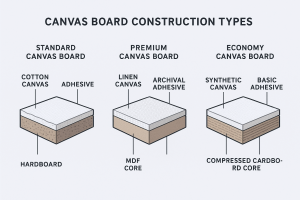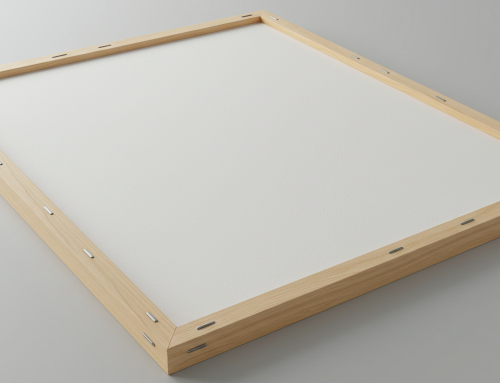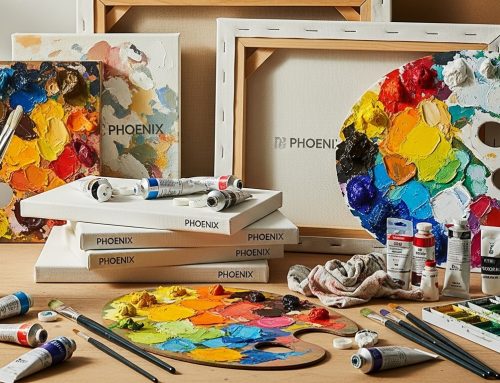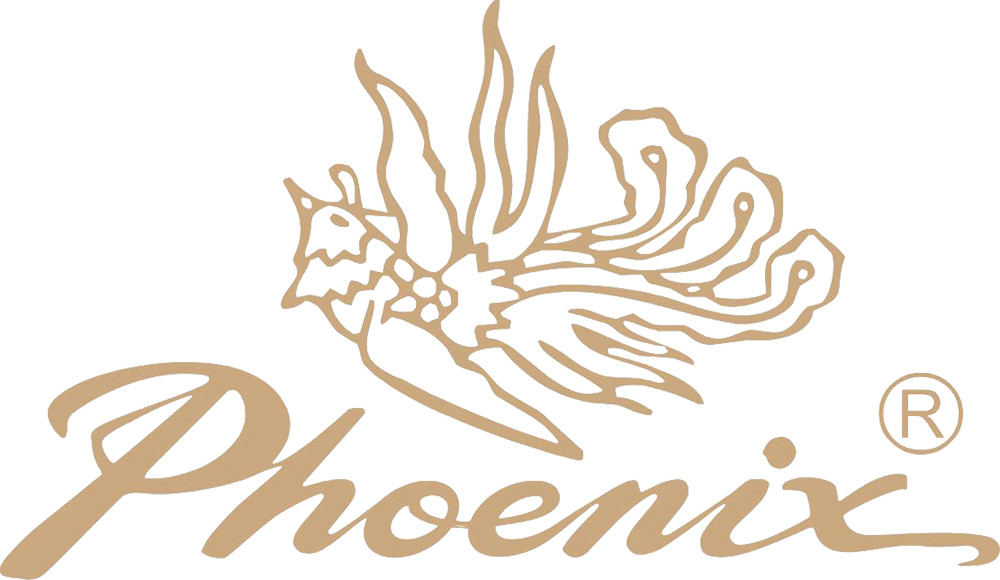Understanding Canvas Boards: Types and Tips for Artists
Canvas boards, commonly known as canvas panels in many art supply contexts. This construction combines the textured feel of canvas with the stability of a hardboard or MDF core, distinguishing it from pure canvas rolls or stretched canvases. Drawing from industry insights and production processes, this advanced guide explores canvas boards in depth—focusing on their build, variations, and specialized applications for artists. We’ll address common misconceptions, compare them to similar surfaces, and provide pro-level techniques to enhance your workflow, including a deep dive into custom size canvas boards for painting to support wholesale needs.
Clarifying Canvas Boards: Structure and Key Distinctions
Canvas boards are not standalone canvas fabric but a composite product: a layer of primed canvas (often cotton or linen weave) mounted onto a sturdy backing material like MDF, hardboard, or high-density cardboard. This backing provides rigidity, preventing warping and ensuring a flat surface for detailed work. Production typically involves sourcing core boards (e.g., ribbed plates or gray boards from regions like Shandong or Canton in China), drying them to control moisture, precise cutting, adhering the canvas with glue, labeling, cleaning, and packaging—all under strict quality checks to maintain standards.
Key attributes include:
- The backing resists deformation, making canvas boards ideal for transport and long-term storage.
- The fabric is pre primed with gesso for immediate use, offering texture without the need for stretching.
- Thinner and lighter than stretched canvases, with prices starting at $2-10 per board, especially in bulk for wholesale.
- Less “bounce” for heavy impasto; may require edge sealing in humid environments to prevent bubbling or glue failure.
In art supplies, “canvas board” and “canvas panel” are often used interchangeably, referring to the same product—a canvas-wrapped rigid board. However, some distinctions emerge: Canvas panels tend to appeal to a broader audience, including beginners, due to their widespread availability and lower cost in bulk packs. Canvas boards, in contrast, are sometimes positioned as more refined versions, emphasizing higher-quality backings (e.g., archival MDF) and superior priming for professional longevity. This subtle difference highlights canvas boards’ focus on craftsmanship, as seen in premium brands like Winsor & Newton or Fredrix, which prioritize even adhesion and moisture resistance.
Focus on Material and Application of Canvas Boards
Building on core construction, canvas boards vary by backing material, canvas weave, and priming to suit nuanced artistic demands—avoiding redundancy with general painting board categories like gesso or wood panels. For sustainability, look for eco-friendly variants with FSC-certified backings or low-VOC adhesives to reduce environmental impact.
1. MDF-Backed Canvas Boards
- Description: Canvas fabric adhered to medium-density fiberboard (MDF) cores, known for smoothness and warp resistance.
- Applications: Excels in high-contrast acrylic pours or dry media overlays; supports digital printing for hybrid art.
- Available Formats: From mini 4×6 for studies to oversized 30×40 for statements; custom sizes possible for wholesale.
- Pros: Excellent durability; eco-friendly options with low-formaldehyde MDF.
- Cons: Heavier than cardboard variants; avoid prolonged water exposure.
- Pricing Insight: $3-12 per board, with bulk discounts for wholesale.
2. Hard board Backed Canvas Boards
- Description: Tempered hardboard (e.g., Masonite) as the core, with canvas mounted for a lightweight yet robust feel.
- Applications: Ideal for impasto in oils or encaustic wax builds; hardboard’s density resists degradation.
- Available Formats: Standard rectangles plus custom shapes like circles for installations.
- Pros: Slim profile for easy framing; cost-effective for practice.
- Cons: May dent if mishandled; check for smooth edges post-cutting.
- Pricing Insight: $2-8 per board, scalable for wholesale customization.
3. Cardboard-Backed Canvas Boards
- Description: High-density cardboard or composite as backing, glued with canvas for an economical option.
- Advanced Applications: Mixed-media fusions, like embedding LED elements or UV-reactive paints.
- Pros: Ultra-light and affordable; easy to customize with additional seals; some include integrated hanging hardware.
- Cons: Less archival than MDF; monitor moisture to prevent bubbling.
- Pricing Insight: $1-5 per board, ideal for bulk wholesale.
Factor in your workflow: MDF for permanence, hardboard for mobility, cardboard for affordability. For eco-conscious artists, prioritize recycled or low-VOC options to address sustainability gaps.
Compare Canvas Boards in Context
To position canvas boards distinctly, here’s an expanded comparison emphasizing scenarios where they outperform rolls, sheets, papers, or general painting boards. This includes a cost-benefit analysis for wholesale: Custom bulk production can reduce costs by 20-50% vs. retail, but requires quality checks for consistency.
| Surface Type | Core Structure | Key Strengths | Challenges | Optimal Media | Cost Efficiency (per sq ft) | Scenarios |
| Canvas Boards | Canvas fabric on rigid backing (MDF/hardboard/cardboard). | Precision layering, travel-ready, eco-options, customizable for wholesale. | Fixed size limits (unless custom); minimal flex. | Oils with glazing, acrylic builds. | $0.75-2.50 (lower in bulk custom) | Studio series, hybrid digital-physical art, wholesale production. |
| Canvas Rolls | Loose fabric for DIY stretching. | Scalable to murals, full customization. | Labor-intensive setup; storage issues. | Large-scale oils. | $0.25-1.25 | Gallery installations requiring tension. |
| Canvas Sheets | Cut pieces, unstretched. | wide use for testing; easy to cut. | Prone to creases; needs framing post-use. | Quick acrylic sketches. | $0.40-1.75 | Experimental prototypes. |
| Canvas Papers | Paper with canvas emboss. | Disposable practice; ultra-light. | Limited durability; not for finals. | Dry pastels, initial concepts. | $0.15-0.60 | Travel journals, low-stakes ideation. |
Unlike broader painting boards (e.g., plain MDF or wood), canvas boards prioritize the tactile canvas feel, making them superior for texture-driven work without the prep of raw surfaces. For wholesale, canvas boards offer better scalability than rolls due to pre-assembly.
Custom Size Canvas Boards for Art Supplies: Mainly considered for Wholesale and Painting
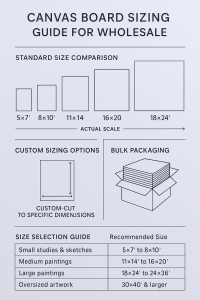
For artists or wholesalers seeking canvas boards for painting in non-standard dimensions, custom size options provide flexibility—especially in bulk. Brands like Fredrix, Arteza, Phoneix offer customization, but DIY or wholesale production allows for tailored fits (e.g., oversized for murals or mini for series). Here are essential attention points to ensure quality and avoid common pitfalls:
- Measurement Accuracy: Always measure twice—account for 1/8-1/4 inch bleed for canvas wrapping. Use precise tools like calipers; inaccuracies can lead to uneven priming or framing issues.
- Material Selection: Choose backing based on size—MDF for large (e.g., 48×60 inches) to prevent warping; hardboard for medium (up to 24×36) for lightness. Opt for acid-free canvas to avoid yellowing; for wholesale, source bulk eco-materials like recycled MDF to cut costs and appeal to sustainable buyers.
- Adhesion and Priming: Apply glue evenly to avoid air pockets; press under weight for 24 hours. Add 2-3 extra gesso layers for smoothness, sanding between coats—crucial for custom sizes where factory priming may vary.
- Stable Testing: For wholesale batches, test for warping by exposing to humidity (e.g., 50-70% RH); reinforce large customs with cradles. Consider weight—oversized boards need thicker backings (1/4 inch+) for durability.
- Wholesale Tips: Order in lots of 50+ for economies of scale (10-30% savings); ensure supplier QC for moisture content (<10%) to prevent defects. Health/safety note: Use low-VOC glues and ventilate during cutting to avoid dust inhalation.
Custom sizes fill a gap for unique projects, but prioritize testing to maintain professional quality.
Canvas Boards Techniques for Professionals
Elevate your practice with these specialized methods, focusing on integration with modern tools and troubleshooting:
Step 1: Optimized Setup
- Evaluate surface: Use a light table to check for imperfections; apply custom toners (e.g., imprimatura for warm undertones).
- Eco Tip: Opt for water-based sealants to reduce environmental impact.
- Troubleshooting: If warping occurs, store flat in low-humidity (<50% RH); repair bubbles by re-gluing edges.
Step 2: Technique
- Acrylic Mastery: Employ masking fluids for sharp edges; layer with gels for 3D effects on the stable base.
- Oil Expertise: Use alkyd mediums for faster drying; experiment with sgraffito scratching to reveal underlayers. Health/Safety: Ventilate well when using solvents to avoid fumes.
- Mixed-Media Innovation: Incorporate resin pours or fiber embeds, leveraging the board’s strength.
- Detailed Tutorial: For a surreal portrait—prime with metallic gesso, build forms with thin veils, finish with UV varnish. Duration: 4-6 hours, tools: Fan brushes, glazing medium.
Step 3: Post-Production Excellence
- Archival Finishing: Apply isolation coats before varnishing; consider cradling for depth.
- Presentation Hack: Use magnetic frames for modular displays in exhibitions.
- Digital Integration: Scan finished boards for NFTs or AR apps—export at 300 DPI for high-res prints.
Canvas Boards Frequent asked questions
How do canvas boards perform with solvents in advanced oil painting?
Triple-primed canvas boards effectively resist breakdown from solvents, making them suitable for thinning paints or creating washes in detailed oil work. For optimal safety, maintain good ventilation in your workspace and choose low-VOC or odorless solvents like Gamsol to minimize health risks.
What are the best canvas boards for large-scale projects without warping?
Opt for cradled MDF-backed canvas boards, which provide excellent stability and can handle sizes up to 48 inches or larger without distortion. For custom or oversized pieces, test them in humid environments to ensure long-term performance.
How can canvas boards integrate with digital tools?
Scan your completed paintings on canvas boards to generate NFTs or produce high-quality digital prints for broader distribution.Enhance the experience by using apps like Adobe Capture or Artivive for augmented reality overlays, blending traditional art with interactive digital elements.
Where can I source sustainable canvas board options?
Search online for FSC-certified brands that prioritize eco-friendly materials, such as those using recycled plastic frames or sustainably sourced. You can also upcycle older boards by re-priming them, extending their life and reducing waste.
How should I store and maintain canvas boards to avoid problems?
Store canvas boards flat or upright in a cool, dry area, keeping them away from direct sunlight and high humidity to prevent warping or degradation.com For maintenance, dust them gently with a soft brush; if minor warps occur, lightly humidify the back side to restore flatness.

